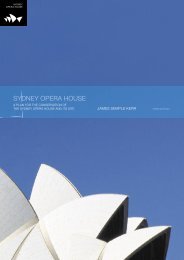July 2 â 3 - Sydney Opera House
July 2 â 3 - Sydney Opera House
July 2 â 3 - Sydney Opera House
You also want an ePaper? Increase the reach of your titles
YUMPU automatically turns print PDFs into web optimized ePapers that Google loves.
As a class brainstorm and record words or phrases that sum up what students learned about Indigenous<br />
history, culture and recurrent social themes from the film/s.<br />
Exploring narrative structure<br />
Both documentaries and drama portray stories. Ask students to explain what they think is meant by the word<br />
‘story’. Are there common characteristics to stories? Record and display ideas. Ask students to contrast and<br />
compare techniques and effectiveness in telling stories through film and book. List similarities, differences,<br />
strengths and weaknesses.<br />
During the next few days have pairs of students discuss one or two of the viewed films. Encourage them to<br />
complete worksheet 3 or 4 and to respond to the following questions:<br />
• What is the title of the film?<br />
• Where and when does the film take place?<br />
• Who is the main character?<br />
• What problem/s does the main character have? How does the main character solve the problem?<br />
• What is the story about?<br />
• What happens in the end? How was the problem resolved?<br />
• What genre or type of film is it e.g. action-adventure, mystery, science fiction?<br />
• Do you think it is a true story? Why? Why not?<br />
As a class identify typical patterns in film narratives. Encourage students to make statements, for example,<br />
• Most films start by telling us about the main character and where this character lived.<br />
• The main character usually has a problem that needs to be solved.<br />
• By the end of the film the main character has changed in some way.<br />
• Many of the stories turn full circle using similar images and at the beginning and the end of the films.<br />
• Stories are often based on traditional tales.<br />
• In most films problems are resolved and there is a happy ending.<br />
Ask students if the Message Sticks films adopted a typical film narrative style. In which ways are Message<br />
Sticks films similar and in which ways are they different?<br />
Introduce students to simple story structure and related terminology. Select one or two films viewed by<br />
students and encourage them to identify the orientation, complication and resolution of each film story.<br />
Record and display this information. Worksheets 5 and 6 may assist with this activity.<br />
Discuss different ways that Message Sticks films ended. Select several films and consider how many had<br />
happy endings. In what ways are the endings of these films like real life?<br />
Storyboards<br />
Storyboards are important for planning the shots for each scene based on the script. They are used for both<br />
documentary and live action productions. A storyboard uses rough drawings like a comic book to show what<br />
you are planning to shoot in each shot. This is where you plan the composition and framing of the shots for<br />
your production. The storyboard also has the character’s dialogue and any action is written beneath each<br />
shot. In a storyboard, each sketch must fill the frame in exactly the same way the shot will fill the frame on<br />
the screen. Each character and prop is drawn to show the size that it will be in the finished film.<br />
Message Sticks Teacher Kit 2008 ©ACMI 8

















